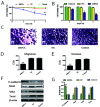Ang-2 promotes lung cancer metastasis by increasing epithelial-mesenchymal transition
- PMID: 29560103
- PMCID: PMC5849167
- DOI: 10.18632/oncotarget.24061
Ang-2 promotes lung cancer metastasis by increasing epithelial-mesenchymal transition
Abstract
Lung cancer is the most common malignant tumor with increasing angiopoietin-2 (Ang-2) and a high rate of metastasis. However, the mechanism of Ang-2 enhancing tumor proliferation and facilitating metastasis remains to be clarified. In this study, Ang-2 expression and its gene transcription on effects of biological behaviors and epithelial-mesenchymal transition (EMT) were investigated in lung cancers. Total incidence of Ang-2 expression in the cancerous tissues was up to 91.8 % (112 of 122) with significantly higher (χ2=103.753, P2=7.883, P=0.005), differentiation degree (χ2=4.554, P=0.033), tumor node metastasis (TNM) staging (χ2=5.039, P=0.025), and 5-year survival rate (χ2 =11.220, P2=18.881, P2=0.81, P=0.776) or III & IV (χ2=1.845, P=0.174). Over-expression of Ang-2 or Ang-2 mRNA in lung A549 and NCI-H1975 cells were identified among different cell lines. When silencing Ang-2 in A549 cells with specific shRNA-1 transfection, the cell proliferation was significantly inhibited in a time-dependent manner, with up-regulating E-cadherin, down-regulating Vimentin, Twist, and Snail expression, and decreasing invasion and metastasis of cancer cell abilities, suggesting that Ang-2 promote tumor metastasis through increasing EMT, and it could be a potential target for lung cancer therapy.
Keywords: Ang-2; EMT; RNA interference; lung cancer; prognosis.
Conflict of interest statement
CONFLICTS OF INTEREST No potential conflicts of interest were disclosed.
Figures





Similar articles
-
[Abnormal expression of angiopoietin-2 associated with invasion, metastasis and prognosis of lung cancer].Zhonghua Yi Xue Za Zhi. 2018 Apr 24;98(16):1261-1266. doi: 10.3760/cma.j.issn.0376-2491.2018.16.015. Zhonghua Yi Xue Za Zhi. 2018. PMID: 29747316 Chinese.
-
Twist may be associated with invasion and metastasis of hypoxic NSCLC cells.Tumour Biol. 2016 Jul;37(7):9979-87. doi: 10.1007/s13277-016-4896-2. Epub 2016 Jan 27. Tumour Biol. 2016. PMID: 26819207
-
FoxM1 overexpression promotes epithelial-mesenchymal transition and metastasis of hepatocellular carcinoma.World J Gastroenterol. 2015 Jan 7;21(1):196-213. doi: 10.3748/wjg.v21.i1.196. World J Gastroenterol. 2015. PMID: 25574092 Free PMC article.
-
Angiogenin elevates the invasive potential of squamous cell lung carcinoma cells through epithelial‑mesenchymal transition.Oncol Rep. 2016 Nov;36(5):2836-2842. doi: 10.3892/or.2016.5107. Epub 2016 Sep 19. Oncol Rep. 2016. PMID: 27667357
-
Silencing Snail suppresses tumor cell proliferation and invasion by reversing epithelial-to-mesenchymal transition and arresting G2/M phase in non-small cell lung cancer.Int J Oncol. 2017 Apr;50(4):1251-1260. doi: 10.3892/ijo.2017.3888. Epub 2017 Feb 21. Int J Oncol. 2017. PMID: 28259904
Cited by
-
High expression of Tie-2 predicts poor prognosis in primary high grade serous ovarian cancer.PLoS One. 2020 Nov 5;15(11):e0241484. doi: 10.1371/journal.pone.0241484. eCollection 2020. PLoS One. 2020. PMID: 33151982 Free PMC article.
-
Effects of Angiogenic Factors on the Epithelial-to-Mesenchymal Transition and Their Impact on the Onset and Progression of Oral Squamous Cell Carcinoma: An Overview.Cells. 2024 Jul 31;13(15):1294. doi: 10.3390/cells13151294. Cells. 2024. PMID: 39120324 Free PMC article. Review.
-
[Research Advances of Ang-2 in Non-small Cell Lung Cancer].Zhongguo Fei Ai Za Zhi. 2018 Nov 20;21(11):868-874. doi: 10.3779/j.issn.1009-3419.2018.11.09. Zhongguo Fei Ai Za Zhi. 2018. PMID: 30454550 Free PMC article. Review. Chinese.
-
Angpt2/Tie2 autostimulatory loop controls tumorigenesis.EMBO Mol Med. 2022 May 9;14(5):e14364. doi: 10.15252/emmm.202114364. Epub 2022 Mar 10. EMBO Mol Med. 2022. PMID: 35266635 Free PMC article.
-
Ang2-Targeted Combination Therapy for Cancer Treatment.Front Immunol. 2022 Jul 8;13:949553. doi: 10.3389/fimmu.2022.949553. eCollection 2022. Front Immunol. 2022. PMID: 35874764 Free PMC article. Review.
References
-
- Malvezzi M, Carioli G, Bertuccio P, Boffetta P, Levi F, La Vecchia C, Negri E. European cancer mortality predictions for the year 2017, with focus on lung cancer. Ann Oncol. 2017;28:1117–1123. - PubMed
-
- Cassidy RJ, Zhang X, Patel PR, Shelton JW, Escott CE, Sica GL, Rossi MR, Hill CE, Steuer CE, Pillai RN, Ramalingam SS, Owonikoko TK, Behera M, et al. Next-generation sequencing and clinical outcomes of patients with lung adenocarcinoma treated with stereotactic body radiotherapy. Cancer. 2017;123:3681–3690. - PubMed
-
- Brock M, Mei Y. Protein functional effector sncRNAs (pfeRNAs) in lung cancer. Cancer Lett. 2017;403:138–143. - PubMed
LinkOut - more resources
Full Text Sources
Other Literature Sources
Research Materials
Miscellaneous

